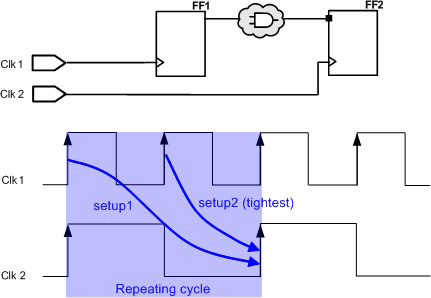7.1 Understanding Inter-Clock Domain Analysis
When functional paths exist across two clock domains (the register launching the data and the one capturing it are clocked by two different clock sources), you must provide accurate specification of both clocks to allow a valid inter-clock domain timing check. This is important especially when the clocks are specified with different waveforms and frequencies.
When you specify multiple clocks in your design, consider whether the inter-clock domain paths are false or functional. If the paths are functional, perform setup and hold checks between the clock domains in SmartTime. Unless specified otherwise, SmartTime considers the inter-clock domain as false, and therefore does not perform setup or hold checks between the clock domains.
If you have several clock domains that are subset of a single clock (such as if you want to measure clock tree delay from an input clock to a generated clock), you must configure Generated Clock Constraints for each of the clock domains in order for SmartTime to execute the calculation and show timing for each of the inter-clock domain paths.
Once you include the inter-clock domains for timing analysis, SmartTime analyzes for each inter-clock domain the relationship between all the active clock edges over a common period equal to the least common multiple of the two clock periods. The new common period represents a full repeating cycle (or pattern) of the two clock waveforms (as shown below).

For setup check, SmartTime considers the tightest relation launch-capture to ensure that the data arrives before the capture edge. The hold check verifies that a setup relationship is not overwritten by a following data launch.
